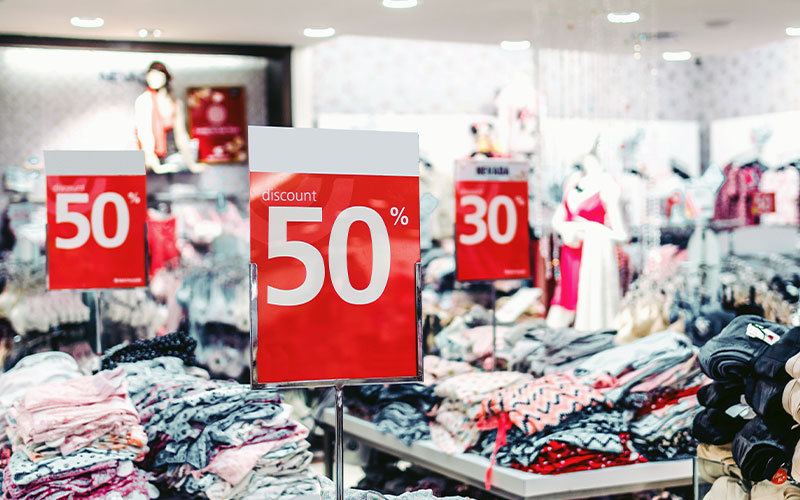Fashion Retailers Could Be Left Paying the Price If They Don’t Take Advantage of AI
Setting the right price has always been a complex question for fashion retailers. On the one hand, a high price will risk losing customers – according to McKinsey, customers will not return to a retailer if prices are more than 30% higher than competitors. Whereas a low price leaves the retailer with little-to-no profit.
Promotions have been a common tactic over the past few years to drive more sales; however, fashion retailers need to find the right time to do this. If discounts are applied too early, potential profits will be eroded. If they come too late, they could find it difficult to reignite customer interest in the item at all. Customers can also quickly become conditioned to the discounting process if it is too predictable, and will simply wait for their desired items to be marked down.
To date, many fashion retailers have largely made pricing decisions based on instinct or simplistic analysis. In an increasingly challenging market, retailers need to embrace artificial intelligence (AI) to ensure that these pricing decisions meet business objectives.

The AI Difference
While there are a lot of factors at play to keep prices on-trend, retailers who use AI can make a real impact on sales. These include:
- Use Data to Your Advantage: By making recommendations based on numerous data sources rather than just looking back at historical pricing levels, AI helps retailers find the right price point. After all, customer demand for flip flops in the summer can be driven as much by factors such as the weather as it is by the price. AI helps to isolate the impact of price, making it possible to evaluate the true elasticity of demand.
- Outside Influences: The next step for retailers is understanding and factoring in the range of influences that may counteract any price change, such as the weather or other wider national events. For example, there might be a heatwave meaning there is greater demand for shorts, or a global event leading to production issues and demand outstripping supply.
- Analyze Datapoints: There are also internal data points to analyze, such as historical return rates and what impact price has on these. Applying AI allows retailers to do more with these insights than ever before. Rules-based solutions allow users to make obvious links, such as price-matching a key rival. This is not always a necessary step; however, AI can help retailers to understand which items need to be matched and which do not.
- Prediction Capabilities: By cutting out the uncertainty and generic nature of more simplistic estimates, AI facilitates a major strategic shift: businesses can move away from looking back at old reports, instead of looking forward to predict future demand. It can also speed up the decision-making process by making recommendations in real-time. This allows retailers to react quickly and be confident they have the optimal price on shop floors and in online stores.
- Plan for the Unplanned: When times of uncertainty hit, retailers can often be left in the dark. As is happening now with COVID-19, retailers are being forced to shutter stores as community members socially distance. AI allows retailers to quickly shift their in-store strategy to online by offering appropriate price discounts, free shipping promotions, etc. while modifying their buying behaviors to meet lower demand.
Challenges to Overcome
So why is it not yet common practice for fashion retailers to use AI within the pricing decision-making process? There are two key reasons AI will struggle to get a foot in the door if decision-makers don’t buy-in:
- Status Quo: As a study by Mirko Kremer and Stefan Minner underlines, many people reject systematic interventions when they’re making important decisions, as they prefer to use personal experience and gut feeling. Initial adoption could also be blocked if fashion retailers are unwilling to adapt inflexible set rules they have always used. For example, once the price of an item has gone down, it cannot come back up.
- Technology or Lack Thereof: The next challenge is some retailers don’t have the technology to allow AI-driven pricing to work in practice. For instance, traditional retailers without electronic shelf labels will have to physically adjust the price on individual items in stores. In addition, some legacy systems cannot set different prices at individual stores, meaning retailers will be unable to follow AI recommendations to charge lower prices on the high street than for premium airport stores.

Fashioning a Path to Success
Those able to overcome the initial challenges will reap the rewards. Many online fashion retailers are already using AI to set prices—they are likely to be more familiar with adjusting prices fairly frequently. However, many traditional operators have found it harder to leave conventional thinking behind. Retailers might view AI as ‘the unknown,’ but in fact, it puts them in the know by making better-informed decisions than ever before.
A lot of businesses talk about data being their most important asset. AI-driven pricing represents a chance for fashion retailers to practice what they preach. Setting the right price is the single biggest profit driver a retailer is in control of, as a 1% increase in price for the right items can lead to twice as much profit as a 1% reduction in costs would.
By supporting retailers to make the best decisions possible, AI can tangibly boost profitability by 15% over the course of a season. Pricing is the easiest start for fashion retailers to begin their AI journey as it gives them quick returns with minimal business change. Those fashion retailers that adopt AI-driven pricing will ultimately be the ones best placed to react to the ever-fluctuating retail environment. So don’t risk being left behind!

